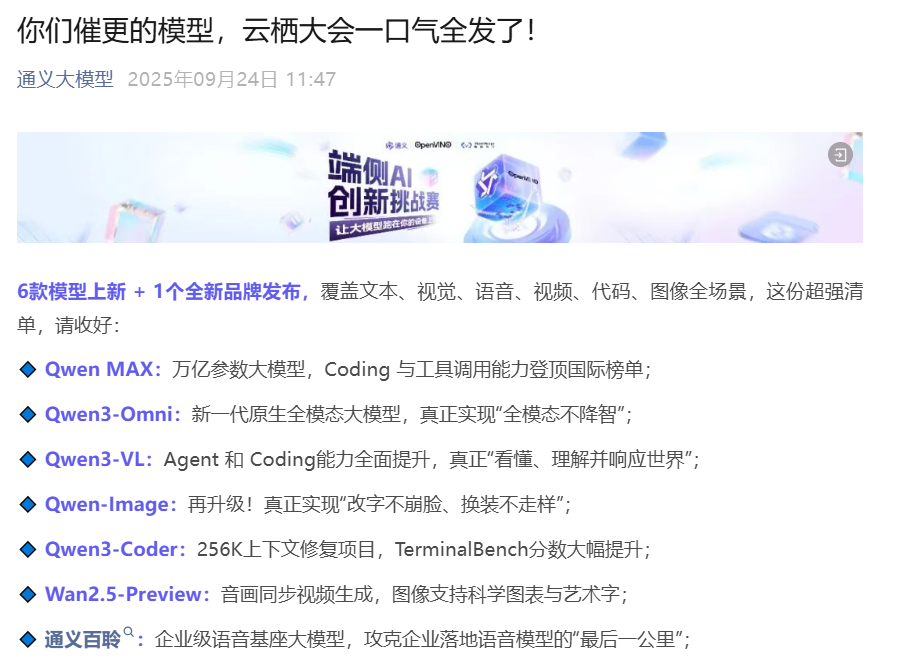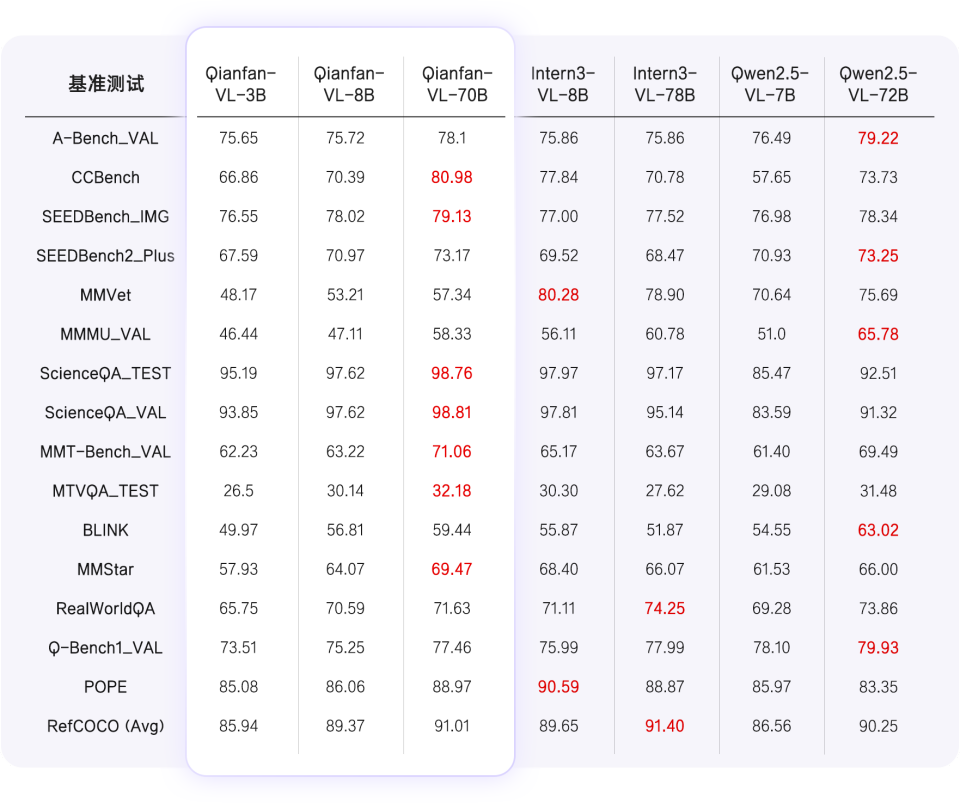The Dawn of Open Source in Large Model Era
![]() 10/14 2025
10/14 2025
![]() 442
442
Author|Lin Feixue
Editor|He Kun
Operations|Chen Jiahui
Produced by|LingTai LT (ID: LingTai_LT)
Header Image|Publicly sourced image from the internet
The landscape of large model competition is quietly undergoing a transformation.
Closed-source models, once the go-to strategy for industry leaders, were perceived as a robust competitive barrier. However, in September 2025, tech giants such as Alibaba, Tencent, and Baidu concurrently unveiled their open-source models, drawing significant attention with their synchronized and impactful moves.
These companies are now showcasing their most cutting-edge technologies, spanning image recognition, dialogue systems, code generation, and 3D modeling. The traditional approach of building barriers through technological secrecy is giving way to a new paradigm: opening up core model technologies to external developers for iterative improvement and rapid adoption.
As AI demands fragment into increasingly niche and diverse deployment scenarios, open sourcing has transitioned from a debatable choice to a fundamental capability for major players. It's akin to a high-stakes card game where most cards are now on the table, and the outcome hinges not on who holds the cards, but on who can play them most skillfully and sustain their position longest.
Open Source: No Longer a Dilemma
As Tencent, Alibaba, and Baidu roll out their heavyweight models, the spotlight is not just on the models themselves but also on their collective embrace of open source.
On the surface, this may appear as a coincidental alignment, but a deeper analysis reveals it as a strategic response to evolving market dynamics. Open sourcing is no longer an optional extra but a critical imperative. Those who navigate this transition effectively may gain a competitive edge in the next round.
According to comprehensive media reports from Tencent's Hunyuan official account and Tianyancha, on September 28, Hunyuan Image 3.0 was officially launched and open-sourced. Tencent's Hunyuan official account described it as the "first industrial-grade native multimodal image generation model with 80 billion parameters, currently the best-performing and largest open-source image generation model, comparable to industry-leading closed-source models." Two days prior, on September 26, Hunyuan 3D-Omni and Hunyuan 3D-Part were also released and open-sourced.
This series of moves underscores Tencent's strategy to leverage external developers' expertise, enabling faster and more refined advancements in complex tasks like 3D modeling and image generation on a broader scale.
However, as major companies' models grow increasingly sophisticated, it's prudent to lay down the cards and foster collaboration rather than hoard them. This approach can transform isolated efforts into more substantial outcomes, driving continuous upgrades in the overall ecosystem.
According to a September 24 report by The Beijing News, Alibaba unveiled seven models at the Cloud Town Conference, including its flagship model Qwen3-Max, the next-generation foundational model architecture Qwen3-Next, and a series of related models. According to the Tongyi Qianwen Qwen official account, it has taken the lead in open-sourcing the flagship model Qwen3-VL-235B-A22B of the Qwen3-VL series for visual understanding, encompassing both Instruct and Thinking versions.

▲Figure: Tongyi Large Model Official Account
Faced with diverse industry demands, open sourcing has also emerged as an effective pathway to accelerate technological practicality. According to a September 23 report by Shanghai Securities News, Baidu Intelligent Cloud Qianfan announced the launch of a new visual understanding model, Qianfan-VL, and fully open-sourced it.
The model series includes three size variants: 3B, 8B, and 70B, tailored for enterprise-level multimodal application scenarios, representing deeply optimized visual understanding large models. Qianfan-VL possesses foundational general capabilities while also featuring specialized enhancements for high-frequency demands in industrial deployment, such as OCR and educational vertical scenarios.
The underlying message is clear: models are tools, and their practical deployment hinges on accessibility and cost control. By delving into enterprise-level multimodal application scenarios, Baidu showcases its technological prowess while lowering application barriers, enabling more businesses to integrate at reduced costs.
From collective iteration at the R&D stage to rapid deployment in industrial applications, a series of developments indicate that open-source strategies wield undeniable strategic value and are gradually becoming a key driver for major companies' growth. At the R&D level, open sourcing consolidates dispersed efforts. At the industrial level, it enables more businesses to overcome barriers and effectively utilize models.
The Engine Powering the Future
As developers and enterprise clients become accustomed to operating within specific open-source ecosystems, the resulting massive computational demands, reliance on higher-performance paid versions, and supporting cloud services and industry solutions are expected to naturally flow into the commercial streams of major companies. Open sourcing has thus evolved from a single move into the engine driving the entire ecosystem.
The dual-wheel drive of technological evolution and practical application deployment is rewriting the rules of the game. For major companies aiming to build extensive ecosystems, open sourcing seems inevitable. The real challenge lies in the extent to which they can open source. By laying down their cards more comprehensively, major companies are not showing off but attempting to make the market and industry revolve around their ecosystems.
Now that a consensus has formed, the next competitive edge lies in who can open source more extensively and offer more substantial content.
Going all-in doesn't mean simply piling parameters to the ceiling but covering as many modalities, scenarios, and applications as possible. Substantial content doesn't mean symbolically open-sourcing a few versions but presenting a complete set of deployable model capabilities. Such open sourcing should leave no gaps for developers, making it clear to upstream and downstream industries that this is a deterministic open sourcing—not just usable but highly effective.
Comprehensive media information from Tianyancha shows that Alibaba meets the needs of diverse developers by providing a large-scale, multimodal model matrix. Its strategic intent may be to make Alibaba's model library the top choice for developers. According to a September 29 report by Economic Observer, Alibaba's Tongyi series has cumulatively open-sourced over 300 models, with downloads exceeding 600 million and over 170,000 derivative models.
Tencent and Baidu have adopted slightly different approaches. From the content shared on Tencent's Hunyuan official account, Tencent's open-source focus seems to be on showcasing its differentiated capabilities. Whether it's complex 3D generation or high-semantic image creation, this open-source initiative helps Tencent establish strong connections with professional creators and enterprise clients.
Baidu, on the other hand, appears to be offering a combined hardware-software approach, deeply integrating its models with its self-developed Kunlun Core P800 computing card. According to Shanghai Securities News, the Kunlun Core P800 provides powerful computational support, ensuring efficient processing of massive data and complex algorithms while supporting parallel computing for single tasks on a scale of 5,000 cards.

▲Figure: Baidu Intelligent Cloud Qianfan Official Account
The report states, "In general capability benchmark tests, the Qianfan-VL series models (3B, 8B, 70B) demonstrated significant core advantages. From visual understanding to professional domain Q&A, model performance improved notably with increasing parameter scale."
Although major companies have varying focuses in their open-source strategies, a clear industry trend has emerged. Open sourcing is no longer about minor adjustments but represents a full-commitment open posture by major companies. Despite differing styles, the goal is the same. Major companies strive to extend open sourcing as much as possible, not just as a display of strength but also as a release of confidence.
However, freely sharing substantial content is just the first half of the game.
The true determinant of success lies in the second half—who can translate these open-source capabilities into industrial entry points and user stickiness, making developers and enterprise clients unconsciously reliant on the major companies' cloud infrastructure, APIs, and deeply customized enterprise-level services.
Major Companies Compete on a New Playing Field
As top-tier model capabilities gradually become public resources through open sourcing, the battle among major companies has quietly shifted to a new playing field. The technological entry gap is narrowing, and the industry's focus is rapidly shifting. The next competition will no longer be about the superiority of the technology itself but about the breadth and depth of the ecosystem.
To succeed in this new ecological competition, Alibaba's long-term goal of building a vast model matrix may be to establish the Tongyi model library as a foundational platform for AI development. For example, will developers habitually turn to its model library for solutions when handling related tasks?
Unlike Alibaba, Tencent's approach may rely on its vast content ecosystem and social application accumulations to establish advantages in relevant fields. For instance, with deep roots in gaming and social media, it has a natural inherent demand for highly complex and expressive 3D content and images. By focusing its open-source efforts on 3D generation and image creation, it aims to showcase its differentiated capabilities.

▲Figure: Tencent Hunyuan Official Account
This is not just a display of technological prowess but more like an ecological strategy. When external developers, especially game developers, animators, and designers, deeply integrate Hunyuan models into their creative workflows, Tencent may achieve a leap from being a tool provider to a rule setter in digital content production. Once this path is firmly established, the resulting user stickiness and ecological barriers are often harder to replace.
Baidu's path seems to be based on its long-standing advantages in computational power and stability as a search giant and AI pioneer, deeply integrating model open sourcing with its self-developed Kunlun Core P800 computing card to form a natural extension of its technological route. Furthermore, by building a complete ecosystem from chips and frameworks to model applications, it becomes relatively more friendly for critical scenarios like government, finance, and education, where Baidu has already made significant inroads.
In other words, Baidu aims to synchronously open up its deeply optimized model capabilities and reliable, efficient computational support to target clients and developers, reducing trial-and-error and integration costs. Through such ecological construction, Baidu's competitiveness will no longer be confined to the model level but will take deeper root in industrial services.
These differentiated layouts indicate that the competition for large models among major companies is shifting direction. They are not starting from scratch in a new arena but projecting and amplifying their inherent core advantages into the realm of large models through open-source strategies.
In the past, success depended on who had a larger team or more investment. Now, it's about who can translate their advantages into ecological attractiveness, making developers think of "using it" first in specific scenarios. Once developers become accustomed to a particular open-source model, enterprise clients will naturally follow when building applications, potentially turning this system into a de facto "ace."
In Conclusion
From the debate over whether to open source to increasingly extensive and substantial open-sourcing, and now to ecological competition on a new playing field, the path of large models for Chinese major companies has shown a sense of certainty. These companies are no longer satisfied with competing on a single product level but are extending the competition to broader developer communities and industry scenarios through repeated open-sourcing efforts.
Although closed-source models still hold value in specific areas, open sourcing has undoubtedly become the inevitable destination and main battlefield for major companies' large model strategies when it comes to building broad industrial influence. Over the next few years, competition in large models will intensify. Open sourcing lowers technological barriers but also accelerates competition.
The true measure of success is not how much is open-sourced today but who can bring developers, industry clients, and application scenarios into their ecosystem after opening up. Only by doing so can they take the initiative at the new table. Ultimately, the battle over large models among major companies is not about who runs out of cards first but who can make more people willingly follow suit.








